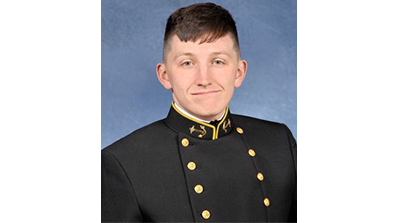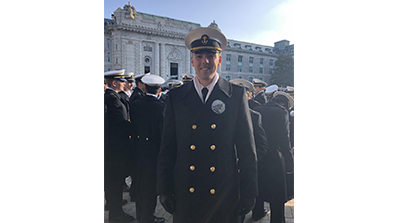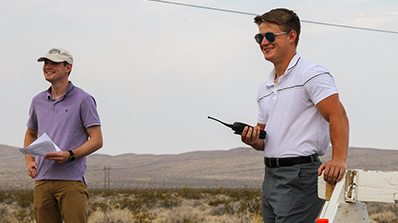The U.S. Department of Energy National Nuclear Security Administration’s Nevada National Security Site (NNSS) hosted eight interns from the U.S. military this summer. Two interns were cadets from the U.S. Military Academy (West Point) and six were midshipmen from the U.S. Naval Academy, all seeking experience in a variety of career fields. The short-term program allowed them to attend various trainings throughout the summer months.
Six interns reflected on their experiences and shared the highlights.
Matthias Williams, a cadet from West Point, is a senior systems major with a focus in artificial intelligence. Following graduation, he plans on commissioning as a Chemical Corps Officer. During his summer internship at the NNSS, he was able to grasp a better understanding of radiological disaster response.
Luke Lhota, a nuclear engineering major at the U.S. Naval Academy, was amazed with the scale of operations taking place at the NNSS. During his internship, he rotated between the Remote Sensing Laboratory-Nellis, the North Las Vegas location and the Site. Specific examples of his hands-on experience included going to Ice Cap at the Site to see how detectors were used during underground testing, working with a modern post-maintenance technology to calibrate it and get it operational for use, and exploring a machine shop to see how in-house detectors are made.

“I was able to ask endless questions about a side of nuclear engineering I have never before been exposed to in my time at the U.S. Naval Academy,” Lhota said. “I gained ample amounts of experience with radiation detection, as I was able to look at how people in the past and present use the detectors I learned about in school to solve real-world problems. Additionally, the amount of history and knowledge all throughout each facility baffled me, and it was truly an honor to work with so many professional, competent and intelligent individuals each and every day.”
Nik Kennedy, a senior at the U.S. Naval Academy, will soon be heading to the Naval Postgraduate School in Monterey, California, to complete his master’s degree in mechanical engineering. While at the NNSS, he was able to learn how the NNSS conducts material checks with various government agencies and public and private laboratories, and also learn the history of the Site by touring various locations.
Nathan Matalavage is entering his fourth and final year at the U.S. Naval Academy. This spring, he will graduate with a bachelor’s in nuclear and mechanical engineering. Following graduation, he will also attend the Naval Postgraduate School and then enter the U.S. Navy Submarine Force.
“During my time at the NNSS, I learned a lot about problem solving and teamwork,” Matalavage said. “Watching the NNSS team encounter problems and meticulously seek out the best solution was a great learning experience for me.”

Alex Carter, a U.S. Naval Academy midshipman, spent one of his summer training rotations at the NNSS. Carter is entering his senior year majoring in mechanical and nuclear engineering. Upon graduation, Carter will become an officer in the U.S. Navy. He has already been selected to do surface warfare and attend a master’s program at the Naval Postgraduate School, furthering his mechanical engineering education.
A few key projects Carter had the opportunity to work on were testing photomultiplier tubes, calibrating the photomultiplier, 3D printing, assisting with aerial operations and performing guard duties during a rocket launch at the Site. Another project involved going through hundreds of phone kits, downloading software and performing a final check for the radiological teams at the Remote Sensing Laboratory-Nellis.
Carter said he was thankful to learn from the experienced scientists and engineers who were more than welcoming. He left this summer with an abundance of hands-on experience and new professional connections.
“At the NNSS, we learned real-world applications within the nuclear industry and the various avenues of work currently being done surrounding nuclear material,” Carter said. “It was an amazing opportunity that we were very thankful for.”
The eight interns representing the U.S. military were among the more than 40 students selected to participate in the summer NNSS Student Program. For information about internships at the NNSS, visit the Student Programs webpage.

